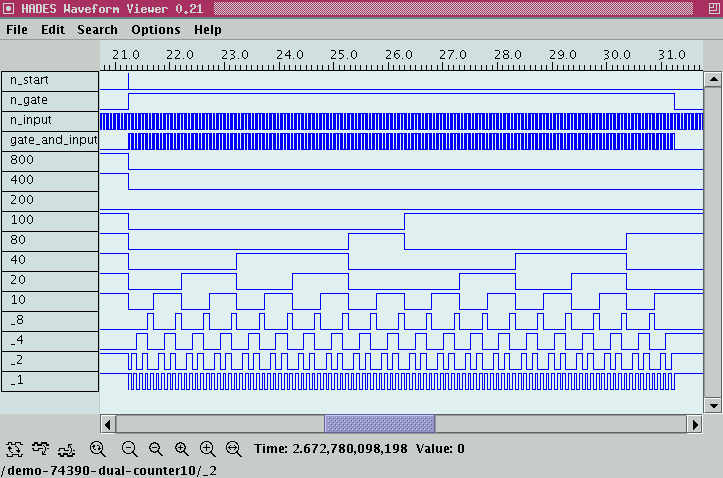

Applets
contents
visual index
 introduction
introduction std_logic_1164
std_logic_1164 gatelevel circuits
gatelevel circuits delay models
delay models flipflops
flipflops adders and arithm...
adders and arithm... counters
counters
 asynchronous...
asynchronous...
 asynchronous...
asynchronous...
 frequency di...
frequency di...
 synchronous ...
synchronous ...
 synchronous ...
synchronous ...
 up/down counter
up/down counter
 asynchrounou...
asynchrounou...
 749x counters
749x counters
 7493 1:16 co...
7493 1:16 co...
 7490 1:10 co...
7490 1:10 co...
 7492 1:12 co...
7492 1:12 co...
 74590 counter
74590 counter
 74390 decima...
74390 decima...
 frequency co...
frequency co...
 pulse-generator
pulse-generator
 digital clock
digital clock
 digital clock
digital clock LFSR and selftest
LFSR and selftest memories
memories programmable logic
programmable logic state-machine editor
state-machine editor misc. demos
misc. demos I/O and displays
I/O and displays DCF-77 clock
DCF-77 clock relays (switch-le...
relays (switch-le... CMOS circuits (sw...
CMOS circuits (sw... RTLIB logic
RTLIB logic RTLIB registers
RTLIB registers Prima processor
Prima processor D*CORE
D*CORE MicroJava
MicroJava Pic16 cosimulation
Pic16 cosimulation Mips R3000 cosimu...
Mips R3000 cosimu... Intel MCS4 (i4004)
Intel MCS4 (i4004) image processing ...
image processing ... [Sch04] Codeumsetzer
[Sch04] Codeumsetzer [Sch04] Addierer
[Sch04] Addierer [Sch04] Flipflops
[Sch04] Flipflops [Sch04] Schaltwerke
[Sch04] Schaltwerke [Sch04] RALU, Min...
[Sch04] RALU, Min... [Fer05] State-Mac...
[Fer05] State-Mac... [Fer05] PIC16F84/...
[Fer05] PIC16F84/... [Fer05] Miscellan...
[Fer05] Miscellan... [Fer05] Femtojava
[Fer05] Femtojava FreeTTS
FreeTTSAs frequency is defined as 'pulses per second', it is sufficient to just count pulses during one second (or any other time interval) to measure the corresponding input frequency. To this end, a 'gate' component is used to limit the counting of input pulses to a time interval of known length. Obviously, when the time interval is exactly one second, no additional scaling is necessary, and the final counter value directly corresponds to the frequency of the input signal.
Pressing the 'start' button first resets the 4-digit decimal counter; it also initializes and starts the output pulse from the 'GATE' subdesign. This subdesign uses the reference clock of 100 KHz to create a single 1-second output pulse. (Changing the reference clock also changes the output pulse duration proportionally). The AND-gate masks the input signal to the 'GATE' pulse duration.
The following image shows typical example waveforms during a measurement:

See the next applet for the internals of the GATE subdesign which is also built from 74390 components. The idea is to create a highly accurate pulse duration in the range of seconds by counting thousands (millions) of short pulses, instead of trying to create a single pulse of the required length. While the latter is very difficult with electronical components, a cheap (temperature-stabilized) quartz-oscillator can be used to generate a very precise signal in the few-MHz range.